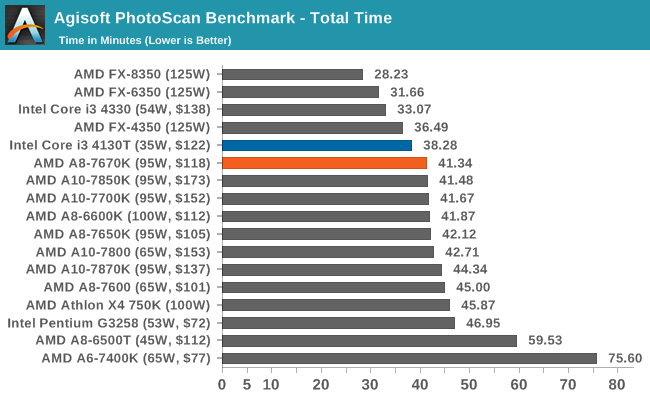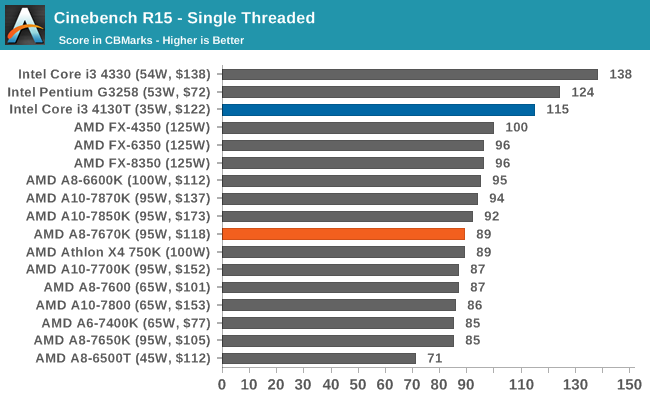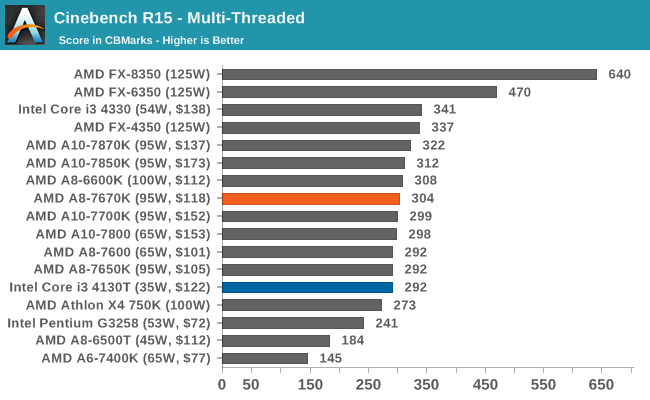The AMD A8-7670K APU Review: Aiming for Rocket League
by Ian Cutress on November 18, 2015 8:00 AM ESTProfessional Performance: Windows
Agisoft PhotoScan – 2D to 3D Image Manipulation: link
Agisoft PhotoScan creates 3D models from 2D images — a process that is very computationally expensive. The algorithm is split into four distinct phases, and different phases of the model reconstruction require either fast memory, fast IPC, more cores, or even OpenCL compute devices to achieve the best performance. Agisoft supplied us with a special version of the software to script the process, where we take 50 images of a stately home and convert it into a medium-quality model. This benchmark typically takes around 15 to 20 minutes on a high-end PC on the CPU alone, with GPUs reducing the time.

PhotoScan shows most APUs performing around 41 to 42 minutes, which suggests that there is a bottleneck in the core design.
Cinebench R15
Cinebench is a benchmark based around Cinema 4D, and is fairly well known among enthusiasts for stressing the CPU for a provided workload. Results are given as a score, where higher is better.


HandBrake v0.9.9: link
For HandBrake, we take a video (a 2h20 640x266 DVD rip) and convert it to x264 format in an MP4 container. Results are given in terms of the frames per second processed, and HandBrake uses as many threads as possible.











154 Comments
View All Comments
zeeBomb - Wednesday, November 18, 2015 - link
Go go Rocket APU!jaydee - Wednesday, November 18, 2015 - link
Would be nice to see this compared to the latest Intel offering. Any plans on reviewing Skylake i3/Pentium? I doubt Intel sends out samples of those, but they've been publicly available for a month or so.hojnikb - Wednesday, November 18, 2015 - link
Yep, HD530 is pretty beefy and coupled with ddr4 it would probobly be quite competitive with apus gpu.Valantar - Wednesday, November 18, 2015 - link
You did see the table comparing the A8-7670Ks iGPU with the i5-6600s HD 530, right? It's literally one paragraph up from the comments in the conclusion, if you missed it. To sum things up: the 7670K wins every test outright, with only a few specific 99th percentile numbers not being clear wins. Even with the Intel CPU running DDR4 (although at the same frequency as the DDR3 used).nikaldro - Wednesday, November 18, 2015 - link
You said it yourself : Intel's iGPU was intentionally held back.Valantar - Wednesday, November 18, 2015 - link
Testing both chips at Jedec spec is holding one of them back? Othereise, shouldn't both be tested with OCd memory?hojnikb - Thursday, November 19, 2015 - link
Thats just one game though... I want to see a full benchmark comparing more games.Ian Cutress - Wednesday, November 18, 2015 - link
I'm trying to get a source for the whole stack for testing review. Keep fingers crossed. :)nathanddrews - Wednesday, November 18, 2015 - link
I expected the the Intel HD 530 graphics to perform much worse than the 7670K, despite the CPU processing advantage and extra $100 in price. 9-18% faster average frame rates, but very small gains on 99th percentile. The 530 can be found on CPUs all the way down the stack to the $60 Pentiums. I was expecting something closer to a 50% gap, but I'm probably envisioning 7870K vs Haswell IGP.Too bad there's no Carrizo desktop SKU.
imaheadcase - Wednesday, November 18, 2015 - link
This really looks like it should not of even existed. Look at that lineup how close everything is together.